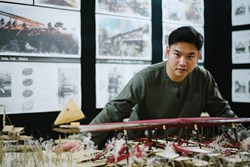Mila Makasini from Te Kura Matatini ki Otago — Otago Polytechnic, School of Architecture is a finalist for his project 'Lalava’i Fonua: Lashing & Weaving [of, in, with] people, place, culture'.
Project description
Tongan diaspora of Aotearoa face disconnection with their fonua [place, people, culture]. Architecture acts as the medium to bind this disconnect.
This disconnection leaves a generation of individuals navigating tensions between the traditions of our ancestral pasts and the unknowns of their future. This project leverages architecture as a practice to actively bridge this gap. Elevating building from a static vessel to a living, breathing, dynamic community member in transforming and transmitting culture.
Lalava'i fonua poses that a fale designed as an active participant in cultural practices serves as the catalyst for identity formation and intergenerational knowledge transfer. Through lalava [lashing & weaving], traditional values with contemporary innovation, architecture becomes a connection, empowering our diaspora community to not only survive but thrive within this new context of Aotearoa.
Located on the green town belt Ōtepoti, this site integrates the functions of Tongan handicrafts, performance, & material arts to be celebrated and allows practices to be passed on to future
generations.
The architecture itself through form and process emulates cultural practices, though no conventional ‘cultural’ motifs are ‘applied’ to the design. Instead, principal values of tā [time] & vā [space] inform design concepts, from which culturally identifiable motifs organically manifest.
On the fale interior a series of handicraft studios, performance spaces, and a material art workshops are demarcated through permeable screening mechanisms. A stair core to the east elegantly houses workshop storage.
An outdoor theatre performance space to the west is intended for large gatherings. From here roof structure above resembles the actions of the performers below. To the north of the site, amenity and utility-type spaces are housed, similar to classical site organisation of Tongan compounds.
The fale is cohesively formed of the following principal materials: Native hardwood timber, steel plate structural connections, basalt stone, clay earthen floors, & profiled metal cladding.






